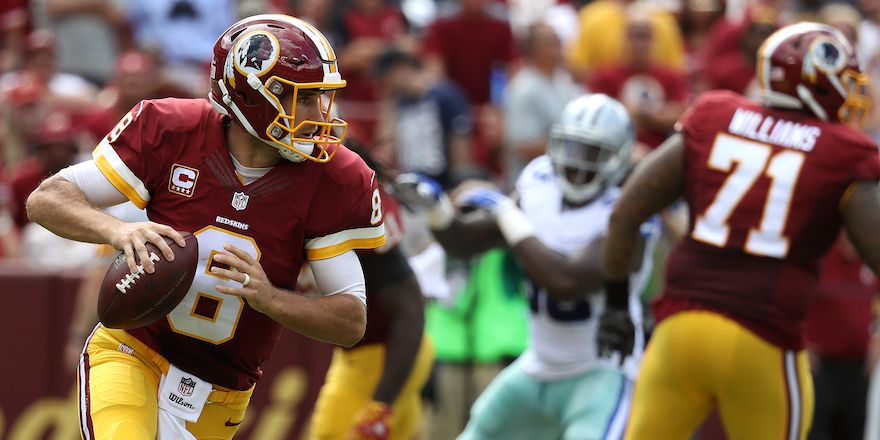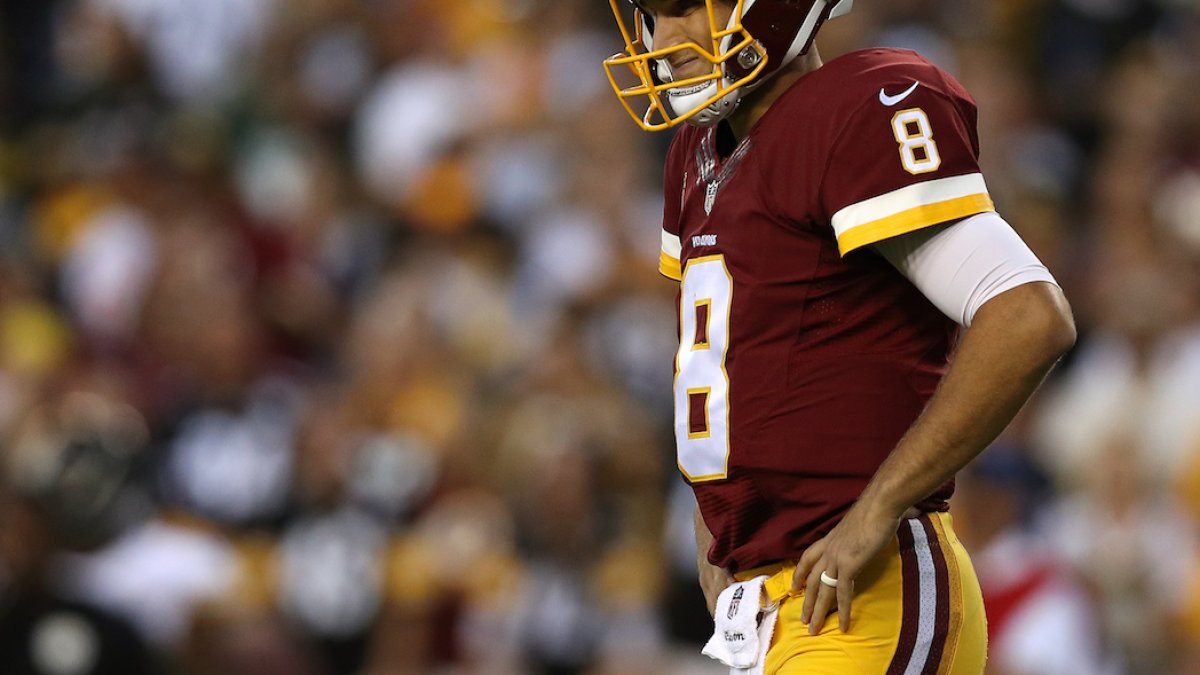We're just two weeks into the season, and already criticism seems to be coming in every direction (possibly even from his own teammates, according reports) on the play of Redskins QB Kirk Cousins and the team's 0-2 start. It began after a Week 1 blowout loss to the Steelers, and continued with a close Week 2 loss to the Cowboys, which saw Cousins throw an ill-advised critical red-zone interception on third-and-goal from the 6-yard line in the fourth quarter. It’s no secret that quarterbacks are under a bigger microscope than most NFL players; with Cousins playing under the pressure of the franchise tag, has the criticism been fair, and what’s the real story? Let’s take an in-depth look at his play through two weeks.
High number of passing attempts
Cousins is currently tied for the NFL lead (with Blake Bortles) in passing attempts, at 89, a number that has risen that high for a couple reasons. The flow of the Week 1 game was off all night, with the defense’s inability to stop Antonio Brown or DeAngelo Williams forcing the Washington offense to throw the ball to get back in the game. This situation could not have played out better for an opposing defense, especially Pittsburgh's unit.
The Steelers' defense is predicated on stuffing the run and making the opposing quarterback play a patient game from the first snap with wide and deep-zone drops, forcing him to throw the ball underneath, and counting on the QB to lose patience and try to fire a ball downfield into a tight zone at some point. That is exactly what happened with Cousins; his first big mistake of the season came on a forced throw in a deep-drop, cover-3 zone interception downfield early in the third quarter, down 17-6 in the game. The Steelers went on to score, making it 24-6, putting the contest out of reach quickly after halftime. Cousins later had a batted pass at the line of scrimmage intercepted in the fourth quarter to give his stat line an ugly look of no touchdowns and two interceptions. The Redskins' QB had a few uncharacteristic misses, and the costly third-quarter pick certainly hurt, but overall, it’s tough to pin the loss on his shoulders, as he made several high-level throws and reads to even make the score what it was.
Last week against the Cowboys, we saw a bit of a different story. Cousins ended with 46 passing attempts (fourth-most in Week 2) as Washington continually decided to throw the ball, handing it off to RB Matt Jones just 13 times. Cousins made a lot of throws, missing just a few targets/reads throughout the game. But of course, the story the game was the costly red-zone interception—the play you’ve likely seen recounted over and over again this week—with Washington up 23-20. The Cowboys were playing bracket coverage (in and out) on TE Jordan Reed on the play, with Barry Church having inside leverage. Reed broke out after 5 yards, freeing up Church to slide in front and make the interception; Cousins was looking left the entire way, and obviously did not see him. It was an inexcusable pick in that situation, and ultimately was the reason for the outcome of the game.

Red-zone woes
Much of the talk has been has been about Cousins' red-zone failures, specifically from the 10-yard line and in, where his stat line of two-for-nine for 5 yards and two interceptions certainly looks ugly. Cousins was incredibly effective in the red zone last season, throwing no interceptions and 22 touchdowns. When you break down his incompletions this year on each throw from inside the 10, though, is he really playing that poorly? His seven incompletions so far go as follows:
- Interception thrown to Cowboys S Barry Church: No excuse, bad play, and incredibly costly.
- Batted pass at line of scrimmage tipped in the air for an interception late in the fourth quarter against the Steelers: Bad luck.
- Overthrow on a switch release, slot fade to TE Jordan Reed: Tight coverage, but not his best throw.
- Two fades to rookie WR Josh Doctson: Doctson failed to hold his line and got pushed wide by the DB. Both were good throws from Cousins, Doctson should help him out here.
- Throwaway: No one open, Cousins threw it out the back of the end zone.
- Blatant missed call by the referees on a Morris Claiborne hold on Pierre Garçon: Timing route, front pylon throw with good ball location, 3rd-and-4, ballgame tied 20-20. This was an inexcusable missed call by the refs at a big moment of the game.
The margin of error in the NFL is so small. If that holding gets called like it should, and Washington punches it in, we could have a completely different tone on Cousins this week.
Manage the expectations, help him out
It’s easy to want to call pass after pass with Cousins and the pass-catching playmakers they have. He’s a high-percentage thrower—Cousins led the league with a 69.8 completion percentage last year—and one of the best post-snap processors in the NFL, owning an uncanny ability to work quickly through progressions and find an open receiver. Cousins' greatest strength can at times be his biggest weakness, with him holding onto the ball a little long on occasion, milking the play for everything it's worth.
However, there are only a few quarterbacks in the NFL who you can consistently rely on to make throw after throw each game with a high number of attempts and not turn the ball over at a high rate. At quarterback, you’re playing the percentages—eventually a bad decision will happen here and there, even with best signal callers. The flow of the Week 1 game dictated a high number of throws, but in Week 2 versus the Cowboys, a stronger commitment to the run may have alleviated some of the pressure on Cousins.
This leads us to the category of where Cousins excels the most: play action. This is an area which is obviously dependent on a play-caller's willingness to call run plays to set up play-actions accordingly, and on the QB to execute when those opportunities present themselves. Last season saw Cousins top the NFL on play-action passes with a 129.1 QB rating, while also leading the league with 11.3 yards per attempt. Cousins currently leads the NFL in non-play-action dropbacks, at 76. Much of an offense's big plays downfield come on play-action, and Washington will need to commit to the run to give Cousins an opportunity to succeed on play-action snaps, allowing the Redskins' talented playmakers on the outside to do what they do best.
Going forward
Let’s keep in mind that Cousins started a little slow last season, as well. In the seven games before the bye week, he had nine touchdowns and eight interceptions before playing at a very high level the last half of the year. Is he pressing a little bit playing under the franchise tag? Maybe. Has he missed some throws you would expect him to hit? Absolutely. But with DeSean Jackson and Pierre Garçon both in contract years, it’s easy to see why the sense of urgency is there in the passing game.
The connection with Jackson downfield has not been up to par yet, but you can expect those attempts to start hitting as they have in the past. Cousins is without a doubt in the top half of NFL starting quarterbacks that a team can consistently win with. Like any QB, he just needs a little help. While the turnovers have been timely/costly thus far, Washington’s offense needs to rally around him going forward and have everyone buying in, knowing this is their guy. With the resiliency Cousins has shown throughout his career, my bet is that he starts playing at a high level sooner rather than later.



 © 2024 PFF - all rights reserved.
© 2024 PFF - all rights reserved.